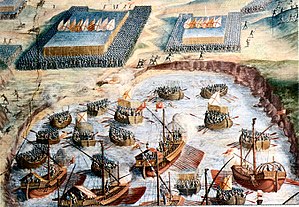São Miguel Island: Difference between revisions
No edit summary |
|||
| Line 106: | Line 106: | ||
==External links== |
==External links== |
||
* [http://www.destinazores.com/en/index.php Azores Tourist Guide] |
|||
* [http://www.sao-miguel-acores.com/en/azores/ Tourist Transport in São Miguel Island (Azores)] |
|||
* {{en icon}} [http://www.pvv.org/~bct/azor/ A photo tour of the island] |
* {{en icon}} [http://www.pvv.org/~bct/azor/ A photo tour of the island] |
||
*[http://theazoresislands.blogspot.com/search/label/S%C3%A3o%20Miguel%20Island The Azores Islands - Site with abundant information about São Miguel Island] |
*[http://theazoresislands.blogspot.com/search/label/S%C3%A3o%20Miguel%20Island The Azores Islands - Site with abundant information about São Miguel Island] |
||
Revision as of 18:19, 9 December 2009
Nickname: The Green Island | |
|---|---|
 | |
| Geography | |
| Location | Atlantic Ocean |
| Coordinates | 37°47′N 25°30′W / 37.783°N 25.500°W |
| Archipelago | Azores Islands |
| Administration | |
Portugal | |
| Demographics | |
| Population | 126,000 |

São Miguel Island (Portuguese pronunciation: [sɐ̃ũ miˈɡɛɫ]; Portuguese for Saint Michael), nicknamed "The Green Island", is the largest and most populous of the Azores Islands archipelago. The island covers 759 km2 (293 sq mi) and has around 140,000 inhabitants, nicknamed Micaelenses. The largest town is Ponta Delgada, with about 45,000 inhabitants.
Geography and environment
São Miguel is 64 km from east to west, and between 8 and 14 km wide. Nicknamed the "Green Island" (Ilha Verde), São Miguel is largely covered with fields and meadows in the lowlands. The ancient laurisilva forest has mostly been replaced by cultivated fields and imported trees and plants. There are some hot springs (caldeiras), generally located in the center of the island, in the area stretching from Povoação to Nordeste. São Miguel has four stratovolcanoes and caldeiras, Sete Cidades, Agua de Pau, Caldeiras and finally Furnas.
The peak area between Sete Cidades and Fogo is a monogenetic volcanic field composed of 270 volcanoes. They are primarily made up of basaltic cones which were formed during Strombolian and Hawaiian-style eruptions. This is the part of the island with most recent volcanic activity. The youngest volcanoes are relatively well dated. It is estimated that 19 eruptions have occurred during the last 3,000 years. Several eruptions have been witnessed and recorded by people. The last one took place in the seventeenth century. The most famous eruption is known as Fogo 2, occurring in 1652.
The highest elevation on São Miguel is the Pico da Vara at 1,103 m. Lying at the eastern end of the island, it is the focus of a Special Protection Area containing the largest remnant of laurisilva forest on the island, which is home to the endemic and critically endangered bird, the Azores Bullfinch.
Cities
Municipalities
Famous people from São Miguel
- Antero de Quental, poet
- Natália Correia, writer/poet
- Pedro Pauleta, football player
- Roberto Ivens, explorer
- Teófilo Braga, politician, writer
- Nelly Furtado's parents migrated from the island to Canada
History
São Miguel in 1427 became the second of the Azores islands to have a Portuguese settlement.
15th century
It is believed that the island was discovered between 1426 and 1439, being marked in portolans from the middle of the fourteenth century as “Green Island”. In 1439 Henry the Navigator authorized the settlement of the Azores by people from Estremadura, Alto Alentejo, Algarve and Madeira through a Carta Régia (a letter from the king describing how things should be). People from other countries also arrived, notably French people and cultural minorities such as Jews and Moors.
The location, climate and fertile soil led to a rapid economic development. The island also became the site of military garrisons and was a commercial center for trade with Africa. It was also a center for the production of sugar and orchil, a dye exported to Flanders for the making of cloth.
16th century

The first capital of the island was Vila Franca do Campo, which was devastated by a major earthquake in 1522.
After this tragedy, the development of the population of Ponta Delgada gained impetus, becoming the new capital in 1546. In the context of the 1580 Portuguese succession crisis, the people from São Miguel Island won the naval Battle of Vila Franca against a French squadron that supported the claims of António, Prior of Crato. During this time, the volcano Fogo 2 erupted, destroying the capital city and causing the death of 250 people.
17th century
With the Portuguese Restoration War (1640), the island regained its position as a commercial center, getting new contacts with Brazil, which was heavily colonized during this period.
18th century
Some of the island’s historic buildings, including mansions and churches, date from this period. This architectural expansion was due to large profits earned from the production of oranges for exportation, whose main market was Great Britain.
19th century
In 1831, during the Liberal Wars, after the landing of Liberal troops in Nordeste ordered by the future duke of Terceira, the resistance to the Absolutist regime on the Island was organized. In 1832, the Army, after declaring the Constitution and recognizing Maria II of Portugal as their queen, left Ponta Delgada. After the troubled period of the Liberal Wars, the previous economic expansion resumed, the port of Ponta Delgada was built, and also new crops such as tea, pineapple, and tobacco were introduced.
20th century
The development of the fishing industry and the improvement of agricultural products helped to boost the economy until the present day. Currently, the island is one of the most dynamic political-administrative centers and it is in São Miguel Island where the headquarters of the government of the Azores is.
Gallery
-
NASA satellite photo (North to the top)
-
Eastern São Miguel landscape
-
Lagoa Pao Pique, a volcanic crater lake near Sete Cidades
-
The twin lakes next to the village Sete Cidades
References
- Scarth, Alwyn (2001). Volcanoes of Europe. Oxford University Press. pp. 243 pp. ISBN 0-19-521754-3.
{{cite book}}: Unknown parameter|coauthors=ignored (|author=suggested) (help) - Global Volcanism Program: Azores





